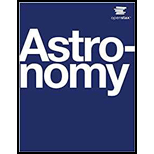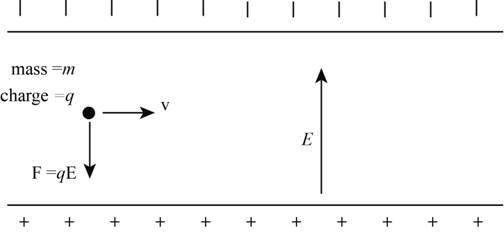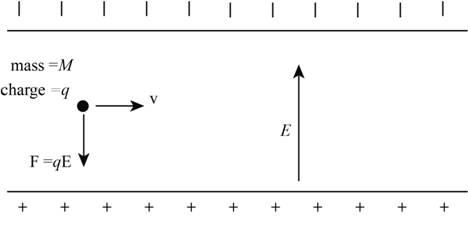
Concept explainers
The physical difference that will give the different impact points, the sign of the charge and also to define how this compares to the gravitational projectile motion case.
Answer to Problem 18TP
The mass of the second particle is 16 times more than the first particle. As both the particle impacts on the positive plate, the charge on the particles must be negative. When two particles are launched in the gravitational field, they must impact the ground at the same point as the acceleration due to the gravity is same for any mass.
Explanation of Solution
Given:
The charge of the particle is identical, that is,
The impact of the second particle on the positive plate is,
The vertical displacement of the particle is equal as,
Formula used:
The required diagram for the first massive particle is shown in figure (1).

Figure (1)
The acceleration in the downward direction of the first particle is given by,
The horizontal displacement of the first particle is given by,
The displacement of the first particle in the
The required diagram for the second massive particle is shown in figure (2).

Figure (2)
The acceleration in the downward direction of the second particle is given by,
The horizontal displacement of the second particle is given by,
The displacement of the second particle in the
Calculation:
The displacement of the first particle in the
The horizontal displacement of the first particle is calculated as,
The displacement of the second particle in the
The horizontal displacement of the second particle is calculated as,
The ratio of horizontal displacement of the first and the second particle is calculated as,
Solve further,
Conclusion:
Therefore, the mass of the second particle is 16 times more than the first particle. As both the particle impacts on the positive plate, the charge on the particles must be negative. When two particles are launched in the gravitational field, they must impact the ground at the same point as the acceleration due to the gravity is same for any mass.
Want to see more full solutions like this?
Chapter 19 Solutions
COLLEGE PHYSICS (OER)
- What is the magnitude of the electric field due to a charged particle at its exact location (r = 0)?arrow_forwardA proton is fired from very far away directly at a fixed particle with charge q = 1.28 1018 C. If the initial speed of the proton is 2.4 105 m/s, what is its distance of closest approach to the fixed particle? The mass of a proton is 1.67 1027 kg.arrow_forwardA Van de Graaff generator is charged so that a proton at its surface accelerates radially outward at 1.52 1012 m/s3. Find (a) the magnitude of the electric force on the proton at that instant and (b) the magnitude and direction of the electric field at the surface of the generator.arrow_forward
- The dome of a Van de Graaff generator receives a charge of 2.0 104 C. Find the strength of the electric field (a) inside the dome, (b) at the surface of the dome, assuming it has a radius of 1.0 m, and (c) 4.0 in front the center of the dome. Hint: See Section 15.5 to review properties of conductors in electrostatic equilibrium. Also, note that the points on the surface are outside a spherically symmetric charge distribution; the total charge may be considered to be located at the center of the sphere.arrow_forwardThe dome of a Van de Graaff generator receives a charge of 2.0 104 C. Find the strength of the electric field (a) inside the dome, (b) at the surface of the dome, assuming it has a radius of 1.0 m, and (c) 4.0 in front the center of the dome. Hint: See Section 15.5 to review properties of conductors in electrostatic equilibrium. Also, note that the points on the surface are outside a spherically symmetric charge distribution; the total charge may be considered to be located at the center of the sphere.arrow_forwardRocket observations show that dust particles in Earths upper atmosphere are often electrically charged. (a) Find the distance separating two dust particles if each has a charge of +e and the Coulomb force between them has magnitude 1.00 1014 N. (b) Calculate the mass of one of the dust panicles if this Coulomb force would accelerate it at 4.50 108 m/s2. (In the upper atmosphere, effects from other nearby charges typically result in a small net force and acceleration.)arrow_forward
- An electron and a proton, each starting from rest, are accelerated by the same uniform electric field of 200 N/C. Determine the distance and time for each particle to acquire a kinetic energy of 3.21016 J.arrow_forwardIntegrated Concepts Figure 18.57 shows an electron passing between two charged metal plates that create an 100 N/C vertical electric field perpendicular to the electron's original horizontal velocity. (These can be used to change the electron’s direction, such as in an oscilloscope.) The initial speed of the electron is 3.00106 m/s, and the horizontal distance it travels in the uniform field is 4.00 cm. (a) What is its vertical deflection? (b) What is the vertical component of its final velocity? (c) At what angle does it exit? Neglect any edge effects.arrow_forwardCalculate the angular velocity of an electron orbiting a proton in the hydrogen atom, given the radius of the orbit is 0.5301010 m. You may assume that the proton is stationary and the centripetal force is supplied by Coulomb attraction.arrow_forward
- Review. From a large distance away, a particle of mass m1, and positive charge q1 is fired at speed in the positive x direction straight toward a second particle, originally stationary but free to move, with mass m2, and positive charge q2. Both particles are constrained to move only along the x axis. (a) At the instant of closest approach, both particles will be moving at the same velocity. Find this velocity, (b) Find the distance of closest approach. After the interaction, the particles will move far apart again. At this time, find the velocity of (c) the particle of mass m1, and (d) the particle of mass m2.arrow_forwardA particle of mass m and charge q moves at high speed along the x axis. It is initially near x = , and it ends up near x = +. A second charge Q is fixed at the point x = 0, y = d. As the moving charge passes the stationary charge, its x component of velocity does not change appreciably, but it acquires a small velocity in the y direction. Determine the angle through which the moving charge is deflected from the direction of its initial velocity.arrow_forward(a) What is the direction of the total Coulomb force on q in Figure 18.46 if q is negative, qa= qcand both are negative, and qb= qcand both are positive? (b) What is the direction of the electric field at the center of the square in this situation?arrow_forward
 Physics for Scientists and Engineers, Technology ...PhysicsISBN:9781305116399Author:Raymond A. Serway, John W. JewettPublisher:Cengage Learning
Physics for Scientists and Engineers, Technology ...PhysicsISBN:9781305116399Author:Raymond A. Serway, John W. JewettPublisher:Cengage Learning Principles of Physics: A Calculus-Based TextPhysicsISBN:9781133104261Author:Raymond A. Serway, John W. JewettPublisher:Cengage Learning
Principles of Physics: A Calculus-Based TextPhysicsISBN:9781133104261Author:Raymond A. Serway, John W. JewettPublisher:Cengage Learning Physics for Scientists and Engineers: Foundations...PhysicsISBN:9781133939146Author:Katz, Debora M.Publisher:Cengage Learning
Physics for Scientists and Engineers: Foundations...PhysicsISBN:9781133939146Author:Katz, Debora M.Publisher:Cengage Learning College PhysicsPhysicsISBN:9781305952300Author:Raymond A. Serway, Chris VuillePublisher:Cengage Learning
College PhysicsPhysicsISBN:9781305952300Author:Raymond A. Serway, Chris VuillePublisher:Cengage Learning College PhysicsPhysicsISBN:9781285737027Author:Raymond A. Serway, Chris VuillePublisher:Cengage Learning
College PhysicsPhysicsISBN:9781285737027Author:Raymond A. Serway, Chris VuillePublisher:Cengage Learning Classical Dynamics of Particles and SystemsPhysicsISBN:9780534408961Author:Stephen T. Thornton, Jerry B. MarionPublisher:Cengage Learning
Classical Dynamics of Particles and SystemsPhysicsISBN:9780534408961Author:Stephen T. Thornton, Jerry B. MarionPublisher:Cengage Learning





